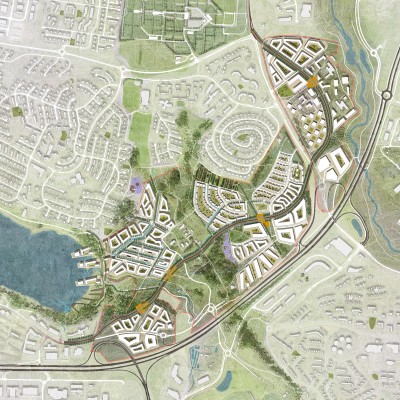
Keldur
OPEN participated in the international competition for a strategic urban development plan for Keldur held by The City of Reykjavik, Iceland. The competition was intended to find high-quality proposals and interdisciplinary teams to be involved in the work ahead, in designing and planning a new urban quarter.
Iceland enjoys global recognition for its cultural heritage and landscape. It is positioned in many people’s consciousness as a place that is both raw and young, but also ancient and wise, with a progressive approach to equality, decision-making and community spirit. As the country’s fast-growing capital, Reykjavik must demonstrate how a growing population might best live, work and play in the context of our global climate and biodiversity emergency.
OPEN’s Keldur proposition illustrates how an urban quarter design can allow a new way of living which reflects global concerns. It is about living well living locally in a way which touches lightly on the earth and reduces carbon emissions from construction and in operation. It leads the way in valuing wellbeing, access to nature and community interactions over and above conventional economic appraisals.

Keldur is an opportunity for Iceland to demonstrate sustainable higher density living on the edge of a city within an urban quarter which allows for living without relying on private car ownership. Other small and young cities have led the way with their own interpretation, staying small but acting big. Iceland can forge its own approach, inspired by the cultural dualities of a young but ancient nation.
Iceland enjoys global recognition for its cultural heritage and landscape. It is positioned in many people’s consciousness as a place that is both raw and young, but also ancient and wise, with a progressive approach to equality, decision-making and community spirit. Reykjavik shoulders the responsibility as the island’s fast-growing capital, of demonstrating how a growing population might best live, work and play in the context of our global climate and biodiversity emergency.
The Keldur proposition demonstrates how an urban quarter is designed which allows a new way of living reflecting global concerns. It is about living well living locally in a way which touches lightly on the earth and reduces carbon emissions from construction and in operation. It leads the way in valuing wellbeing, access to nature and community interactions over and above conventional economic appraisals.
Keldur will be something that Iceland hasn’t seen before – a high density urban quarter which allows for living without needing a private car. Other small and young cities have led the way with their own interpretation, staying small but acting big. Iceland can forge its own approach, inspired by the cultural dualities of a young but ancient nation.

Keldur will show that high land values can be created through a focus on creating vibrant mixed-use neighbourhoods that are walkable, transit-oriented, and offer a range of amenities and services. This would include a mix of residential, commercial, and recreational spaces designed to foster social interaction and community engagement. A dense and mixed-use form will be supported by a new rapid transit route, centrally located to run through the new quarter. Stops along this route will form key high intensity urban nodes, allowing access to other modes of transport and supporting a wide range of services and facilities, from cultural institutions to education to retail.
The residential component of the urban quarter will be designed to provide a variety of typologies and apartment sizes which can support people at every stage of the housing market, with flexibility and adaptability considered from the outset to support the demands of an aging population. Good connections with the natural environment and access to the outdoors are critical to wellbeing.
For older people in particular, getting outside is a significant factor for mobility and can be an important predictor of health. The design of public open space is therefore critical and a range of types and scales of open space are provided, ensuring that everyone is within easy access to usable open space. Blue-green corridors are designed to reach across the site and beyond, creating corridors for water, wildlife and people to move through the landscape while also creating new habitats and enhancing those valuable areas on the site already. This includes Kálfamói, where a fascinating experiment in tree and woodland planting has been underway for decades; the diverse habitats within this small area suggest a planting palette for the rest of the site which is specific to the location and offers clues as to Iceland’s formerly wooded character.

OPEN’s submission illustrated how an innovative new urban quarter would be designed with a strong focus on sustainability, liveability, and connectivity. The plan prioritises pedestrian and cycle-friendly infrastructure, with generous green spaces, community growing areas, play and recreational areas, along with the integration of the BRT route. Land is used as efficiently as possible, locating higher density mixed-use development on flatter and lower areas, with lower density areas on the steeper upper slopes. Areas around the BRT stations are the focus for high intensity areas with a blend of residential, commercial, and cultural spaces, fostering a sense of community and vibrant urban life. These stitch together more employment-focussed areas on the edge of the site with supporting facilities and sustainable transport options.
The unique landscape areas at Kálfamói have been protected and integrated to form a green heart to the plan connecting blue-green infrastructure corridors across and beyond the site. The potential for waterfront development should be explored which would further incorporate Icelandic cultural elements and materials, showcasing the country’s heritage while embracing modern architecture and urban design principles to create a forward-thinking and inclusive urban environment.



